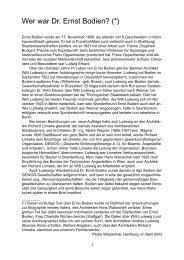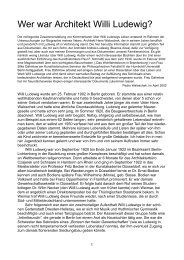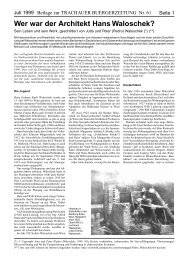Death-Rays as Life-Savers in the Third Reich - Pedro Waloschek ...
Death-Rays as Life-Savers in the Third Reich - Pedro Waloschek ...
Death-Rays as Life-Savers in the Third Reich - Pedro Waloschek ...
Create successful ePaper yourself
Turn your PDF publications into a flip-book with our unique Google optimized e-Paper software.
Foreword<br />
Today we know that <strong>the</strong> ‘death rays’ made famous through science<br />
fiction literature and c<strong>in</strong>ema were never actually deployed, and<br />
certa<strong>in</strong>ly not dur<strong>in</strong>g World War II. The extensive literature on secret<br />
weapons provides us with very few mentions of ‘death rays’, and most<br />
of <strong>the</strong>se refer to desperate publicity stunts by <strong>the</strong> German leadership<br />
towards <strong>the</strong> end of <strong>the</strong> war (see i.e. [Fo92] [Ir64] [Jo78a] [Jo78b]).<br />
However, several proposals were made, which led to <strong>the</strong> establishment<br />
of real research and development projects that aimed (or hoped) to<br />
achieve <strong>the</strong> development of ‘death rays’, or at le<strong>as</strong>t to ga<strong>the</strong>r some of<br />
<strong>the</strong> knowledge considered <strong>in</strong>dispensable for <strong>the</strong> realisation of such<br />
weaponry. This does not belong to <strong>the</strong> world of conjecture; <strong>the</strong>re is real<br />
evidence of activity, which can be reconstructed thanks to archive<br />
documents and witness statements.<br />
Towards <strong>the</strong> end of <strong>the</strong> war, scientists <strong>in</strong> Germany tried to make use<br />
of what funds were still available for research work. Some of <strong>the</strong>se<br />
projects were sensible, o<strong>the</strong>rs less so. They also used such projects <strong>as</strong><br />
pretexts to save <strong>the</strong>ir employees from war services (see Schiebold) or<br />
from deportation <strong>in</strong> concentration camps (see Schmellenmeier). Most<br />
of <strong>the</strong>m were already th<strong>in</strong>k<strong>in</strong>g <strong>in</strong> terms of post-war scientific or<br />
commercial applications. So <strong>the</strong>y were supported and encouraged by<br />
<strong>in</strong>dustrial firms like Brown Boveri (BBC), Philips and Siemens, which<br />
expected a future market for X-ray-produc<strong>in</strong>g mach<strong>in</strong>es for hospitals.<br />
And <strong>the</strong>y were <strong>in</strong> strong competition with US-firms like General<br />
Electric.<br />
However, <strong>in</strong> order to obta<strong>in</strong> <strong>the</strong> materials, f<strong>in</strong>ancial support and<br />
services required for a project, several scientists found it expedient to<br />
declare that <strong>the</strong>ir work w<strong>as</strong> of vital importance to <strong>the</strong> war effort. Their<br />
chances of success fared even better if <strong>the</strong>y could <strong>as</strong>sert that <strong>the</strong>ir<br />
developments were <strong>in</strong>dispensable for produc<strong>in</strong>g a specific weapon,<br />
which could prove decisive for a conclusive (and somewhat<br />
miraculous) victory. Sometimes <strong>the</strong>se proposals were explicit, and<br />
5











